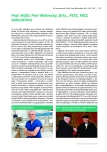Surgical therapy of myocardial infarction
Authors:
Petr Němec; Jiří Ondrášek; Petr Fila; Helena Bedáňová; Petr Pavlík
Authors‘ workplace:
Centrum kardiovaskulární a transplantační chirurgie Brno, ředitel doc. MUDr. Petr Němec, CSc.
Published in:
Vnitř Lék 2014; 60(4): 331-334
Category:
60th Birthday - prof. MUDr. Petr Widimský, DrSc., FESC, FACC
Overview
Introduction:
Coronary artery bypass grafting (CABG) has been replaced by percutaneous coronary interventions in the treatment of myocardial infarction (MI) nowadays. The surgical repair is the only option for mechanical complications of MI. The aim of our study was to assess the results of surgical treatment of MI.
Patients and methods:
From January 2008 to December 2012 one thousand nine hundred fifty nine patients were operated on at Centre of cardiovascular surgery and transplantations in Brno for coronary artery disease, 103 (5.3 %) of them suffered from acute MI. The interval between MI and operations was longer than 24 hours in more than half of the patients. Nineteen patients underwent PCI before operation, 32 were in cardiogenic shock with intraaortic balloon pump in 12, twelve patients were after cardiopulmonary resuscitation and 18 were on ventilation.
Results:
CABG alone was performed in 78 patients, in 25 patients mechanical complication of MI occurred; rupture of papillary muscle with mitral regurgitation in 8, rupture of interventricular septum in 11, rupture of free wall of left ventricle in 1 and evolving aneurysm of left ventricle in 5 patients. Several serious complications occurred in the postoperative period; disturbances of heart rhythm, syndrome of low cardiac output and pulmonary complications with the necessity of prolonged ventilation being the most frequent. Fourteen patients died during hospital stay (mortality 13.4 %).
Conclusions:
Patients after acute MI create the highest-risk group for surgical treatment. The reasons comprise serious preoperative status, delayed reperfusion of ischemic area and serious hemodynamic effect of mechanical complications of MI. A lot of complications may occur during postoperative course and mortality is high. In the survivals the long term follow-up is promising.
Key words:
CABG –CAD – myocardial infarction
Sources
1. Přehled vybraných kardiovaskulárních intervencí v České republice 2011. ÚZIS ČR, NRKI: Praha 2013. ISBN 978–80–7472–033–8. Přehled vybraných kardiovaskulárních intervencí v České republice 2010. ÚZIS ČR, NRKI: Praha 2012. ISBN 978–80–7280–974–5.Přehled vybraných kardiovaskulárních intervencí v České republice 2009. ÚZIS ČR, NRKI: Praha 2011. ISBN 978–80–7280–856–4.Přehled vybraných kardiovaskulárních intervencí v České republice 2008. ÚZIS ČR, NRKI: Praha 2011. ISBN 978–80–7280–855–7.Přehled vybraných kardiovaskulárních intervencí v České republice 2007. ÚZIS ČR, NRKI: Praha 2009. ISBN 978–80–7280–799–4 .
2. Kala P, Němec P, Želízko M et al. Revaskularizace myokardu. Perkutánní koronární intervence a aortokoronární bypass. Vnitř Lék 2012; 58: (Suppl 1): S79-S103.
3. Gu YL, van der Horst ICC, Douglas YL et al. Role of coronary artery bypass grafting during the acute and subacute phase of ST-elevation myocardial infarction. Neth Heart J 2010; 18(7–8): 348–354.
4. Yang EH, Gumina RJ, Lennon RJ et al. Emergency coronary artery bypass surgery for percutaneous coronary interventions: changes in the incidence, clinical characteristics, and indications from 1979 to 2003. J Am Coll Cardiol 2005; 46(11): 2004–2009.
5. Stone GW, Brodie BR, Griffin JJ et al. Role of cardiac surgery in the hospital phase management of patients treated with primary angioplasty for acute myocardial infarction. Am J Cardiol 2006; 85(11): 1292–1296.
6. Widimsky P, Zelizko M, Jansky P et al. The incidence, treatment strategies and outcomes of acute coronary syndromes in the “reperfusion network” of different hospital types in the Czech Republic: results of the Czech evaluation of acute coronary syndromes in hospitalized patients (CZECH) registry. Int J Cardiol 2007; 119(2): 212–219.
7. Thielmann M, Neuhäuser M, Marr A et al. Predictors and outcomes of coronary artery bypass grafting in ST elevation myocardial infarction. Ann Thorac Surg 2007; 84(1): 17–24.
8. Steg PG, James SK, Atar D et al. ESC Guidelines for the management of acute myocardial infarction in patients presenting with ST-segment elevation. European Heart Journal 2012; 33(20): 2569–2619.
9. Park SJ, Kim JB, Jung SH et al. Surgical Repair of Ventricular Septal Defect after Myocardial Infarction: A Single Center Experience during 22 Years. Korean J Thorac Cardiovasc Surg 2013; 46(6): 433–438.
10. Fattouch K, Guccione F, Dioguardi P et al. Off-pump versus on-pump myocardial revascularization in patients with ST-segment elevation myocardial infarction: a randomized trial. J Thorac Cardiovasc Surg 2009; 137(3): 650–656.
11. Filizcan U, Kurc E, Cetemen S et al. Mortality predictors in ST-elevated myocardial infarction patients undergoing coronary artery bypass grafting. Angiology 2011; 62(1): 68–73.
Labels
Diabetology Endocrinology Internal medicineArticle was published in
Internal Medicine

2014 Issue 4
Most read in this issue
- Liver in heart failure
- Right ventricle in severe pulmonary hypertension in congenital heart defects – different and specific.
- Operation of Ebstein anomaly in adulthood – our experience
- Mitral stenosis
